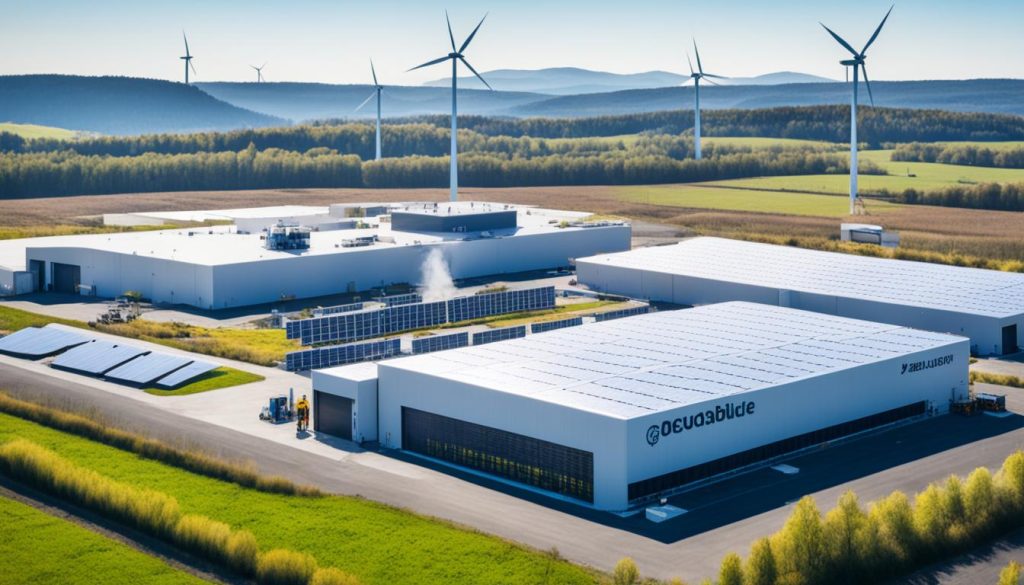Welcome to a world where sustainable practices and eco-friendly solutions are shaping the future of manufacturing. As awareness of our environmental impact grows, companies are embracing renewable energy, green technology, and sustainable development to build a more sustainable world. In this article, we will explore the challenges and opportunities that lie ahead in the realm of green manufacturing and how it can pave the way for a more sustainable future.
Key Takeaways:
- Green manufacturing focuses on sustainable practices in production processes to reduce environmental impact.
- The circular economy promotes the reuse and recycling of materials, transforming linear consumption patterns into circular ones.
- Achieving sustainability goals requires addressing challenges such as resource depletion, climate change, and waste generation.
- Opportunities in green manufacturing include efficiency improvements, innovation in technology and business models, and enhanced reputation.
- Technological innovation and regulatory compliance play critical roles in advancing sustainable solutions and ensuring supply chain sustainability.
Green Manufacturing: Sustainable Production Processes
Green manufacturing is an essential component of sustainable production processes, aimed at minimizing the environmental impact of manufacturing operations. By adopting energy-efficient technologies, reducing waste generation, optimizing resource utilization, and promoting the use of eco-friendly materials, companies can achieve a balance between economic growth and environmental preservation.
Energy-efficient technologies play a significant role in minimizing the consumption of resources and reducing greenhouse gas emissions. This includes the implementation of advanced machinery, energy management systems, and renewable energy sources. By maximizing energy efficiency in production processes, companies can not only reduce their carbon footprint but also lower operational costs.
“Green manufacturing focuses on minimizing the environmental impact of production processes.”
Waste reduction is another important aspect of green manufacturing. It involves implementing strategies to minimize waste generation, improve recycling and reuse practices, and optimize waste management processes. By adopting innovative waste reduction techniques, such as lean manufacturing principles, companies can reduce their overall waste output and minimize their impact on landfills and natural resources.
The use of eco-friendly materials is another key factor in sustainable production processes. By choosing materials that have a lower carbon footprint, are responsibly sourced, and can be easily recycled or biodegraded, companies can contribute to the preservation of natural resources and reduce their environmental impact throughout the entire product lifecycle.
Implementing sustainable production processes not only benefits the environment but also provides long-term advantages for companies. By showcasing their commitment to green manufacturing, companies can enhance their brand reputation, attract environmentally conscious consumers, and gain a competitive edge in the market.
Key Elements of Green Manufacturing:
- Adopting energy-efficient technologies
- Reducing waste generation
- Optimizing resource utilization
- Promoting the use of eco-friendly materials
By incorporating these principles into their production processes, companies can contribute to a more sustainable future and make a significant impact on environmental preservation.
Circular Economy: Redefining Resource Consumption
The circular economy is a revolutionary approach that challenges the traditional linear model of resource consumption. Instead of the take-make-dispose pattern, the circular economy emphasizes the continuous circulation of materials, promoting the principles of reduce-reuse-recycle. This groundbreaking concept aims to redefine resource consumption by encouraging the reuse, repair, remanufacturing, and recycling of products and materials.
By adopting circular economy practices, companies can make significant strides in reducing resource extraction and minimizing waste generation. The continuous circulation of materials enables the preservation of valuable resources, mitigating the environmental impact of resource depletion. As a result, the circular economy becomes a key driver in the transition towards sustainability and a more efficient use of resources.
One of the primary goals of the circular economy is to achieve a closed-loop system, where resources flow in a continuous cycle, without being discarded or lost as waste. This approach not only conserves natural resources but also offers economic benefits, such as cost savings and job creation in sectors related to repair, recycling, and remanufacturing.
The circular economy also promotes innovative business models, including product-as-a-service and sharing platforms. These models encourage product longevity, resource optimization, and reduced material consumption. By embracing the principles of the circular economy, companies can unlock new opportunities for sustainable growth, enhance their competitiveness, and build a resilient and prosperous future.
“The circular economy represents a fundamental shift in the way we produce and consume, offering a powerful solution to the environmental challenges we face. It is a game-changer that allows us to rethink resource consumption and create a more sustainable and prosperous world.”
Benefits of the Circular Economy
Transitioning to a circular economy brings a host of benefits, including:
- Reduced resource extraction: By maximizing the use of existing resources, the circular economy minimizes the need for extracting virgin materials, thereby preserving natural resources.
- Minimized waste generation: The circular economy aims to eliminate the concept of waste by promoting the reuse, repair, and recycling of products and materials. This reduces the burden on landfills and the environmental impact associated with waste disposal.
- Conserved valuable resources: Instead of discarding materials, the circular economy enables their continuous use, extending their lifespan and preserving their value.
- Environmental protection: By reducing resource extraction and waste generation, the circular economy helps mitigate environmental degradation, including climate change, deforestation, and biodiversity loss.
- Enhanced economic opportunities: The circular economy fosters innovation, job creation, and sustainable economic growth in sectors such as recycling, remanufacturing, and renewable energy.
Case Study: Circular Economy in Action
| Company | Initiative | Impact |
|---|---|---|
| Interface | Net-Works® program | Collects discarded fishing nets to create recycled nylon, reducing virgin material consumption and preventing marine pollution. |
| Patagonia | Worn Wear initiative | Promotes the repair and reuse of outdoor gear, extending their lifespan and reducing the environmental impact of the apparel industry. |
| Mud Jeans | Lease-A-Jeans program | Offers leased jeans and facilitates the recycling of returned jeans, contributing to a more circular and sustainable fashion industry. |
The Global Need for a Circular Economy
The linear model of resource consumption is unsustainable in the long term. Global extraction of materials has increased significantly over the years, contributing to environmental degradation. Adopting a circular economy approach is crucial for reducing resource extraction, minimizing waste generation, and conserving resources for future generations.
A circular economy aims to redefine the way we consume resources by promoting a system that prioritizes reduce, reuse, and recycle principles. Instead of the traditional linear take-make-dispose model, the circular economy encourages the continuous circulation of materials, making the most out of every resource.
By embracing the circular economy, companies and individuals can contribute to a more sustainable future. This approach not only minimizes the negative environmental impacts associated with resource extraction but also helps minimize waste generation by promoting the reuse and recycling of materials.
In addition to environmental benefits, the circular economy presents economic opportunities. By adopting circular practices, businesses can improve efficiency, reduce costs, and create new revenue streams. For example, remanufacturing and recycling processes can generate value from waste materials, contributing to a more circular and sustainable economy.
The global need for a circular economy is evident in various sectors, including manufacturing, construction, and consumer goods. By minimizing resource extraction, reducing waste generation, and conserving valuable resources, we can create a more sustainable and resilient future for ourselves and the generations to come.
The Benefits of a Circular Economy
The adoption of a circular economy approach offers several benefits:
- Reduced environmental impact: The circular economy helps reduce resource depletion, greenhouse gas emissions, and pollution.
- Cost savings: Circular practices can reduce the need for raw materials and lower production costs.
- Job creation: The circular economy can stimulate new job opportunities in sectors such as recycling, remanufacturing, and repair.
- Innovation: The transition to a circular economy requires innovative solutions and technologies, driving economic growth and competitiveness.
- Resilience: A circular economy reduces dependence on finite resources, making the economy more resilient to shocks.
Embracing a circular economy is not only a necessity, but also an opportunity to create a more sustainable and prosperous future. By adopting circular practices and minimizing waste generation, we can build a more resilient and resource-efficient society.
| Environmental Benefits of a Circular Economy | Economic Benefits of a Circular Economy |
|---|---|
| Reduces resource depletion | Lowers production costs |
| Minimizes waste generation | Creates new job opportunities |
| Reduces greenhouse gas emissions | Drives innovation and competitiveness |
| Promotes sustainable resource use | Enhances economic resilience |
The Global Need for Green Manufacturing
In today’s world, there is an undeniable global need for green manufacturing. With record-high greenhouse gas emissions contributing to the devastating impacts of climate change, it is crucial that we take decisive action to mitigate these effects. Transitioning to a sustainable future is no longer an option but a necessity.
Green manufacturing practices offer a viable solution to reduce the environmental impacts of industrial production. By adopting energy-efficient technologies, optimizing resource utilization, and using eco-friendly materials, manufacturers can significantly reduce their greenhouse gas emissions. These sustainable practices not only benefit the environment but also contribute to cost savings and operational efficiency.
“Green manufacturing practices not only benefit the environment but also contribute to cost savings and operational efficiency.”
By embracing green manufacturing, industries can play a pivotal role in driving the transition to a more sustainable future. Through the reduction of greenhouse gas emissions and the conservation of natural resources, companies can contribute to global efforts in mitigating climate change and preserving our planet for future generations.

The Benefits of Green Manufacturing
Green manufacturing practices have wide-ranging benefits that extend beyond environmental stewardship. By reducing greenhouse gas emissions, companies can enhance their reputation as socially responsible organizations and appeal to environmentally conscious consumers.
Furthermore, transitioning to green manufacturing opens doors to new market opportunities, as sustainable products and technologies continue to gain popularity. Companies that prioritize environmental sustainability can differentiate themselves from competitors and gain a competitive edge.
“Green manufacturing practices have wide-ranging benefits that extend beyond environmental stewardship.”
As sustainable practices become increasingly important in procurement decisions, green manufacturers have a unique advantage. They can establish strong relationships with customers looking to reduce their own environmental footprints, thus creating long-term partnerships based on shared values.
In conclusion, the global need for green manufacturing is clear. By adopting sustainable practices and reducing greenhouse gas emissions, industries can mitigate their environmental impacts and actively contribute to a sustainable future. It is essential for companies to recognize the significance of green manufacturing and embrace the transition towards a more environmentally conscious and prosperous world.
Challenges of Green Manufacturing and Circular Economy
Implementing green manufacturing practices and adopting a circular economy model come with their fair share of challenges. However, overcoming these obstacles is essential for achieving sustainable development and reducing environmental impact. Let’s explore some of the key challenges faced in the realms of green manufacturing and the circular economy.
The Cost Challenge
One significant challenge that companies encounter when transitioning to green manufacturing and circular economy practices is the cost involved. Initiating sustainability-focused changes often requires significant investments in new technologies, equipment, and infrastructure. These upfront expenses can be a deterrent for some businesses, particularly small and medium-sized enterprises (SMEs) with limited financial resources.
Competition in the Global Market
Another challenge faced by green manufacturers and circular economy proponents is competition in the global market. As sustainability becomes increasingly important to consumers and businesses worldwide, more companies are incorporating eco-friendly practices into their operations. This heightened competition can pose challenges for both established green manufacturers and new entrants as they strive to differentiate themselves and maintain a competitive edge.
The Complexity Conundrum
Implementing green manufacturing and circular economy practices often involves coordination among multiple stakeholders, including suppliers, manufacturers, distributors, and consumers. The complexity of this coordination poses a significant challenge. Aligning the goals and objectives of various stakeholders, ensuring smooth operations, and maintaining compliance with sustainability standards can be intricate and time-consuming.
“The transition to a sustainable future requires overcoming challenges such as high costs, fierce competition, and logistical complexities. Despite these hurdles, the rewards of green manufacturing and circular economy practices outweigh the obstacles.”
| Challenges of Green Manufacturing and Circular Economy | Solutions |
|---|---|
| Cost of initial investments and operational expenses | Seek financial assistance through grants, subsidies, or partnerships. Conduct a thorough cost-benefit analysis to demonstrate long-term savings and return on investment. |
| Competition in the global market | Differentiate products and services through sustainability certifications, brand reputation, and unique value propositions. Continuously innovate and adapt to market demands. |
| Complexity of coordinating multiple stakeholders | Establish effective communication channels and collaboration platforms. Foster partnerships and engage stakeholders in shared sustainability goals. Implement clear guidelines and policies. |
Despite these challenges, the benefits and potential of green manufacturing and the circular economy cannot be ignored. By addressing these obstacles head-on and implementing innovative strategies, companies can establish themselves as leaders in sustainability while contributing to a greener future.
Opportunities of Green Manufacturing and Circular Economy
Green manufacturing and the circular economy present numerous opportunities for companies looking to improve their sustainability practices. By adopting these approaches, businesses can benefit from increased efficiency in production and consumption, foster innovation in technology and business models, and enhance their reputation as responsible corporate citizens.
Improving Efficiency
One of the key advantages of green manufacturing and the circular economy is the potential to achieve greater efficiency in production processes. Implementing energy-efficient technologies, optimizing resource utilization, and reducing waste generation can result in cost savings while minimizing the environmental impact of operations.
Stimulating Innovation
Green manufacturing and the circular economy drive innovation in technology and business practices. Adopting sustainable manufacturing techniques and exploring new business models can lead to the development of groundbreaking solutions that address environmental challenges. This fosters creativity, competitiveness, and market differentiation for companies in the industry.
“Green manufacturing and the circular economy offer a fertile ground for technological innovation and transformative solutions that promote sustainability and resource efficiency.” – Industry Expert
Enhancing Reputation
Adopting green manufacturing practices and embracing the circular economy can significantly enhance a company’s reputation as a responsible corporate citizen. Demonstrating a commitment to sustainable business practices not only resonates with environmentally conscious consumers but also attracts investors and other stakeholders who value environmental stewardship.

Recent Facts and Statistics
Recent facts and statistics reveal the significant role that green manufacturing and circular economy strategies play in addressing environmental challenges. These data highlight the potential of these approaches in reducing greenhouse gas emissions, combating climate change, minimizing food waste, and promoting sustainability across various sectors.
Circular Economy Strategies: A Game-Changer for Greenhouse Gas Emissions
According to recent reports, circular economy strategies have the potential to substantially reduce greenhouse gas emissions. By promoting the reuse, recycling, and remanufacturing of products and materials, these strategies can contribute to a significant decrease in carbon emissions, helping combat climate change and mitigate the environmental impact of traditional linear production and consumption practices.
The adoption of circular economy strategies can also create a domino effect, where resource efficiency leads to emission reductions. This virtuous circle aligns with the goals of sustainable development and paves the way for a greener future.
Combating Food Waste through Circular Economy Principles
The circular economy also offers immense potential in reducing food waste. Globally, an estimated 1.3 billion tons of food is wasted each year. By implementing circular economy principles, such as reducing surplus production, redistributing excess food, and recycling organic waste, we can minimize food waste and its associated environmental impact. This not only conserves resources but also addresses the pressing issue of hunger and chronic food insecurity.
The circular economy’s emphasis on optimizing resource utilization and maximizing the value of products and materials translates into a more sustainable and resilient food system.
Promoting Sustainability in Various Sectors
Recent studies have shown the effectiveness of circular economy strategies in promoting sustainability across diverse sectors. From textiles and electronics to construction and automotive industries, adopting circular economy practices enables resource preservation, waste reduction, and the creation of new business opportunities.
By embracing circular economy principles, companies can contribute to the transition towards a more sustainable and resilient economy while reaping economic benefits and solidifying their position as responsible stewards of the environment.
These recent facts and statistics underscore the significance of green manufacturing and circular economy strategies in achieving environmental sustainability. By reducing greenhouse gas emissions, minimizing food waste, and promoting resource efficiency, these approaches offer practical solutions to address global environmental challenges. Embracing the principles of green manufacturing and the circular economy is not only a necessity for a better future but also a strategic advantage for businesses seeking to thrive in a changing world.
Resource Efficiency: Optimizing Resource Utilization
Resource efficiency is a crucial aspect of green manufacturing. It involves strategically optimizing the utilization of raw materials, energy, water, and waste reduction. By implementing resource-efficient practices, companies can significantly minimize their environmental impact and enhance their overall sustainability.
Optimizing the use of raw materials is essential for reducing the extraction of finite resources from the environment. Through practices such as recycling, reusing, and opting for sustainable materials, companies can minimize their dependence on virgin resources and contribute to a more circular economy.
When it comes to energy utilization, adopting energy-efficient technologies and processes can lead to substantial reductions in greenhouse gas emissions and overall energy consumption. By investing in energy management systems, efficient machinery, and renewable energy sources, companies can mitigate their environmental footprint and save on operational costs in the long run.
Water, being a valuable resource, should be used judiciously in manufacturing processes. Implementing technologies and practices for water conservation and reuse, such as closed-loop systems and water-efficient equipment, can significantly reduce water consumption and contribute to water conservation efforts.
Waste reduction is another critical aspect of resource efficiency. By implementing waste management strategies such as recycling, composting, and waste-to-energy technologies, companies can divert waste from landfills and conserve resources that would otherwise be lost.
Resource efficiency in green manufacturing is not only beneficial for the environment but also creates opportunities for cost savings, improved profitability, and enhanced brand reputation. Optimizing resource utilization not only helps in minimizing environmental impact but also ensures the long-term resilience and competitiveness of businesses.
By prioritizing resource efficiency, companies can align their operations with sustainable development goals, reduce their ecological footprint, and contribute to a greener and more sustainable future.
Key Benefits of Resource Efficiency in Green Manufacturing:
- Reduces reliance on virgin resources and minimizes environmental impact
- Lowers energy consumption and greenhouse gas emissions
- Conserves water resources and minimizes water usage
- Minimizes waste generation and promotes circular economy practices
- Enhances cost savings and improves profitability
- Strengthens brand reputation as an environmentally responsible company
Technological Innovation: Advancing Sustainable Solutions
Technological innovation is a key driver in the quest for sustainable manufacturing practices. By adopting and implementing sustainable technologies, companies can significantly reduce their environmental footprint and pave the way for a more sustainable future. While it may require initial investments in research and development, the long-term benefits and competitive advantages gained make it a worthwhile endeavor.
Sustainable technologies encompass a wide range of innovative solutions that aim to minimize resource consumption, reduce waste generation, and promote energy efficiency. These technologies span across various industries and sectors, offering sustainable alternatives to conventional processes and products.
Research and development play a critical role in advancing sustainable technologies. By investing in R&D, companies can explore new ways to optimize manufacturing processes, develop eco-friendly materials, and improve energy management systems. This proactive approach not only benefits the environment but also enhances operational efficiency and cost-effectiveness.
| Sustainable Technologies | Benefits |
|---|---|
| Renewable Energy Systems | – Reduce dependence on fossil fuels – Lower greenhouse gas emissions – Enhance energy security |
| Smart Manufacturing | – Improve production efficiency – Optimize resource utilization – Enable real-time monitoring and data analytics |
| Green Materials | – Replace conventional materials with more sustainable alternatives – Reduce carbon footprint – Promote circularity and recycling |
| Clean Technologies | – Minimize pollution and waste generation – Improve air and water quality – Meet regulatory requirements |
Advancements in sustainable technologies also open up opportunities for collaboration and partnerships. Companies can work together to share knowledge, expertise, and resources in developing innovative solutions that address common sustainability challenges. This collaborative approach fosters a climate of innovation, promotes knowledge exchange, and accelerates the adoption of sustainable practices.
Driving Sustainable Innovation
Technological innovation not only benefits individual companies but also drives sustainable development globally. By embracing sustainable technologies, industries can collectively contribute to mitigating climate change, conserving natural resources, and creating a more sustainable future for present and future generations.
“Technological innovation is the key to unlocking sustainable solutions that can address the pressing environmental challenges of our time.”
The image below visualizes the interconnectedness of technological innovation, sustainable solutions, and research and development:
Regulatory Compliance and Supply Chain Sustainability
In the realm of green manufacturing, regulatory compliance and supply chain sustainability play crucial roles in achieving environmental goals and ensuring a sustainable future. As manufacturers embrace sustainable practices, they must also navigate the complex landscape of environmental regulations and ensure that their entire supply chain upholds sustainable criteria.
Regulatory compliance involves adhering to environmental regulations set by governing bodies. This includes monitoring and limiting greenhouse gas emissions, managing waste disposal responsibly, and minimizing environmental impact. Manufacturers must stay informed about evolving regulations and implement necessary measures to meet compliance standards.
Additionally, promoting supply chain sustainability is essential for green manufacturing. Companies must work closely with suppliers to ensure they operate in line with sustainable practices and meet environmental standards. This collaboration fosters a shared commitment to environmental stewardship throughout the entire supply chain.
By coordinating with regulators and implementing sustainable practices across the supply chain, manufacturers can endure environmental ethics and achieve compliance goals. Striving for regulatory compliance and embracing supply chain sustainability not only advances green manufacturing but also demonstrates an organization’s commitment to creating a more environmentally responsible future.
Key Points:
- Regulatory compliance is essential for adhering to environmental regulations and minimizing the environmental impact of manufacturing processes.
- Manufacturers must ensure that their suppliers uphold sustainable criteria and operate in accordance with environmental standards.
- Collaboration between manufacturers, regulators, and suppliers fosters a shared commitment to environmental responsibility.
Conclusion
Green manufacturing and the circular economy play a critical role in addressing environmental challenges and advancing sustainability goals. Despite the challenges posed by costs and competition, embracing these approaches offers tremendous opportunities for companies to enhance efficiency, foster innovation, and boost their reputation. By adopting sustainable practices and technologies, businesses can actively reduce their environmental impact and contribute to a more sustainable future.
The integration of green manufacturing practices can lead to resource optimization, waste reduction, and the use of eco-friendly materials. Moreover, the circular economy can revolutionize resource consumption patterns by promoting the continuous circulation of materials through strategies such as reuse, repair, remanufacturing, and recycling. These initiatives reduce the extraction of raw materials, minimize waste generation, and conserve valuable resources for future generations.
In the face of global challenges such as climate change and resource depletion, green manufacturing and the circular economy are not only desirable but also essential. Their adoption can significantly mitigate greenhouse gas emissions, combat environmental degradation, and promote sustainable development. Ultimately, by prioritizing sustainable practices and embracing these concepts, businesses can contribute to a greener and more prosperous future for all.
FAQ
What is green manufacturing?
Green manufacturing focuses on minimizing the environmental impact of production processes by adopting sustainable practices such as energy-efficient technologies, waste reduction, and the use of eco-friendly materials.
What is the circular economy?
The circular economy aims to transform linear production and consumption patterns into circular ones. It promotes the continuous circulation of materials through processes such as reusing, repairing, remanufacturing, or recycling products and materials.
Why is green manufacturing important?
Green manufacturing is important because it helps mitigate environmental impacts, reduce greenhouse gas emissions, and transition to a more sustainable future.
What are the challenges of green manufacturing and the circular economy?
The challenges include costs associated with initial investments and operational expenses, competition in the global market, and the complexity of coordinating multiple stakeholders and technical operations.
What are the opportunities of green manufacturing and the circular economy?
The opportunities include improving efficiency in production and consumption, stimulating innovation in technology and business models, and enhancing a company’s reputation as a responsible corporate citizen.
What are some recent facts and statistics about green manufacturing and the circular economy?
Recent facts and statistics highlight the potential impact of circular economy strategies in reducing greenhouse gas emissions and combating climate change. The circular economy also plays a role in reducing food waste and promoting sustainability in various sectors.
How can resource efficiency be optimized in green manufacturing?
Resource efficiency in green manufacturing involves optimizing the use of raw materials, energy, water, and waste reduction. By adopting resource-efficient practices, companies can minimize their environmental impact and improve overall sustainability.
What is the role of technological innovation in green manufacturing?
Technological innovation plays a crucial role in green manufacturing by helping companies reduce their environmental footprint and advance sustainable solutions. Investing in research and development can lead to long-term benefits and competitive advantages in the market.
What is involved in regulatory compliance and supply chain sustainability in green manufacturing?
Green manufacturing requires manufacturers to comply with environmental regulations and ensure supply chain sustainability. This involves coordination with regulators and implementing sustainable practices throughout the entire supply chain.







